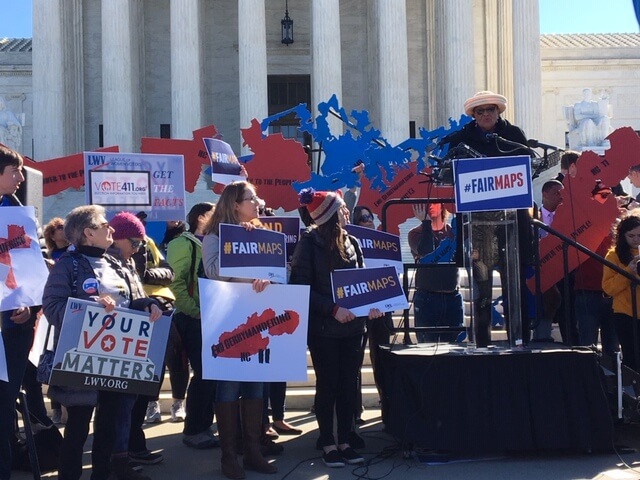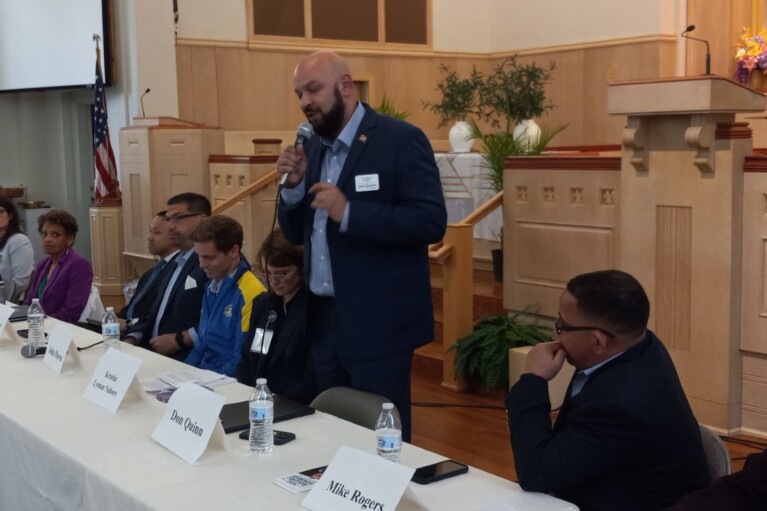Opinion: How ‘Communities of Interest’ May Factor in Md. Congressional Redistricting

“This time, the people of Maryland should be drawing the lines — not the politicians or party bosses,” Gov. Larry Hogan (R) during a redistricting reform announcement a few weeks ago.
When Hogan at his press conference introduced retired judge Alexander Williams Jr. as co-chair of the Governor’s Maryland Citizen Redistricting Commission, I recalled something Williams said at a three-judge panel hearing of the Maryland redistricting case of Fletcher v. Lamone, which challenged the state’s new congressional district lines, in December 2011. His remarks concerned a concept in political line drawing known as “communities of interest.”
“The first thing they tell you up there is to hate the Redskins,” Williams said in a Greenbelt courtroom. “This is Redskins country.” He pointed out that the plaintiffs’ alternate proposal would have created a congressional district spanning from Baltimore southwest to Charles County. He seemed incredulous that Baltimore Ravens fans and fans of the Washington football team could live in the same congressional district!
While discussing the “community of interest” in redistricting, the judges also pointed out somewhat jokingly that the state’s 2011 approved map would change Western Maryland’s District 6 to include Pittsburgh Steelers fans from Allegany County as well as Washington team fans from Montgomery County’s D.C. suburbs.
Writing for the three-judge panel, Reagan-appointed Judge Paul Niemeyer noted that many obvious communities of interest were divided: “That a farmer in Oakland should share a representative with a federal contractor living in Potomac is, we think, a suspect proposition.”
What is a community of interest?
“A community of interest refers to a group of people with a common set of concerns that may be affected by the legislation. Examples of communities of interest include social, cultural, ethnic, racial, and economic groups,” Loyola University Law School Professor Justin Levitt, who runs the website All About Redistricting, wrote in June of 2017.
In Maryland, the social group could be Western Maryland farmers, a cultural group in Baltimore City’s blue-collar white neighborhoods, an ethnic group in heavily Jewish Pikesville, a group of Black voters in Camp Springs, or an economic group along the Interstate 270 corridor.
U.S. House and state legislative districts are redrawn every 10 years, based on census data. It is expected that, after the 2020 Census, the number of Maryland’s eight congressional seats will remain unchanged.
Maryland is not among 11 states that, by constitution or statute, consider keeping “communities of interest” whole when drawing congressional districts.
At the Hagerstown hearing of Gov. Hogan’s 2019 Emergency Commission on Sixth Congressional District Gerrymandering, I testified, “Before 2011 redistricting, 82% of the statewide Maryland membership of Future Farmers of America were in clubs in the old 6th District, while zero percent was in the old 8th District. After the 2011 gerrymander, only 26% of Future Farmers lived in the 6th District, while the number in the 8th jumped from zero to 39% of statewide membership. With this new proposed map [selected by the Emergency Commission], the number in the 8th would once again return to zero.”
Naturally, most of you might not know what I meant, but my point would have been hailed by the “Communities of Interest” advocates across the USA.
On Oct. 27, 2011, I filed suit over the new congressional redistricting map in the United States Maryland District Court, arguing that it unnecessarily diluted the “voting power of agriculture-related electorates” (a community of interest) in the 6th Congressional District. (Gorrell v. O’Malley).
Some federal courts have appointed special masters and required that they draw districts to preserve communities of interest, but when those redistricting plans failed to preserve communities of interest, the court that heard my case was unwilling to order new maps.
On Jan. 19, 2012, the court observed that “while specific considerations — contiguity, compactness, preserving communities of interest, and respect for political subdivisions — may be legitimate considerations in congressional redistricting, they are not constitutionally required.” Therefore, the court determined, my allegation that the plan did not preserve “communities of interest” stated no constitutional violation. Hence, the court dismissed my case.
In a Barry Law Review article titled, “A Shield Becomes a Sword: Defining and Deploying a Constitutional Theory for Communities of Interest in Political Redistricting” (June 10, 2020), Professor Glenn D. Magpantay of Brooklyn Law School cited the Gorrell case and wrote, “This language suggests that communities seeking to preserve the unity of representation should concentrate their efforts on the political bodies drawing the maps in Maryland, as the courts may be unlikely to grant relief on those grounds. But while the result, in this case, seems to have engulfed the originally stated requirement to preserve communities of interest, in actuality, it follows other cases that a breakup of a community of interest is insufficient, alone and by itself, to undo an entire redistricting plan.”
Benisek v. Lamone — What the District Court said
On Nov. 7, 2018, the United States Maryland District Court found the 6th congressional district’s redrawing to be unconstitutional. It ruled that Maryland’s map violated the First Amendment rights of Republican voters in that district and required Maryland to draw new boundaries for the 6th District by a deadline of March 7, 2019. This was where Hogan’s emergency commission came in.
The members of the emergency commission, including retired judge Williams, were instructed by the court to “apply traditional criteria for redistricting — such as geographic contiguity, compactness, regard for natural boundaries and boundaries of political subdivisions, and regard for geographic and other communities of interest — and without considering how citizens are registered to vote or have voted in the past or to what political party they belong.”
BUT. On June 27, 2019, the U.S. Supreme Court ruled 5-4 that partisan gerrymandering claims present political questions that fall beyond the jurisdiction of the federal judiciary. The high court remanded the Benisek case to the lower court with instructions to dismiss due to the lack of jurisdiction.
2022 congressional district map?
Today federal law allows district mapmakers to honor “communities of interest.” The Maryland Citizen Redistricting Commission should consider it seriously, as it was recommended by Gov. Hogan’s 2015 bipartisan 11-member Redistricting Reform Commission.
Some action at the federal level could become relevant.
U.S. Rep. John Sarbanes (D-Md.) has sponsored a sweeping political reform, H.R. 1, the For the People Act of 2021, states, that, among other things, calls for redistricting to be handled nationwide by nonpartisan commissions in all 50 states. The bill includes this language: “Communities of interest may include political subdivisions such as counties, municipalities, tribal lands and reservations, or school districts.”
School districts?
To meet the federal court requirement of “communities of interests,” I have proposed adding clusters of high schools and their feeder schools as, as I mentioned in a commentary from 2019, “How to Fix the 6th Congressional District.” In his blog, The Free State, Associate Professor of Political Science at St. Mary’s College of Maryland Todd Eberly wrote in 2011: “[Gorrell’s] decision to rely on school districts as the basic unit of ‘community’ represents a true understanding of the building blocks of neighborhoods and common ground.”
That sounds like a reasonable goal.
Imagine that Carroll and Frederick counties’ farmers will reunite with other Western Maryland farmers in the new 6th District. Baltimore City’s blue-collar white neighbors will have more tacky Ravens decorations up every Sunday in the fall in the new 2nd District. Residents of Pikesville will wave at their only congressional representative in the parades in the new 3rd District. Residents in Camp Springs will attend a town hall meeting conducted by one member of Congress, instead of two, in the new 4th District. Businesswomen and businessmen on the Interstate 270 corridor will discuss their concerns with one member of Congress, instead of three representatives, in the new 8th District.
All this can be achieved when “communities of interest” are considered during congressional redistricting.
— HOWARD LEE GORRELL
The writer was the first complainant challenging the constitutionality of the apportion of congressional districts of the State of Maryland for the 2010 decade, based primarily on alleged partisan gerrymandering and insufficient consideration of communities of interest. See Gorrell v. O’Malley, 2012 WL 226919 (D. Md. Jan. 19, 2012).




 Creative Commons Attribution
Creative Commons Attribution